Laptop to tablet
In a Nov. 30 patent entitled "Application Programming Interfaces for Scrolling Operations," Apple depicts a laptop that slides into tablet form as an example of a device that would take advantage of the patent's scrolling operations.
The drawings first show a laptop with a traditional keyboard, body, display frame and display. Then, according to the patent, "the laptop device can be converted into a tablet device" by sliding the display across the keyboard.
Since the patent relates to scrolling operations, it would presumably not cover the convertible laptop to tablet form factor. Apple does, however, disclaim in the application that the patent contains "specific exemplary embodiments."
"It will be evident that various modifications may be made thereto without departing from the broader spirit and scope of the disclosure as set forth in the following claims. The specification and drawings are, accordingly, to be regarded in an illustrative sense rather than a restrictive sense," reads the patent.
In its recent revision. to the MacBook Air line, Apple took features from the iPad, such as "solid state storage, instant-on, amazing battery standby time, miniaturization and lightweight construction."
Apple CEO Steve Jobs said during the ultra-thin laptop's unveiling that he and his company had asked themselves, "What would happen if a MacBook and an iPad hooked up?" With both a touchscreen and a keyboard, laptop and tablet configurations, these figures from the scrolling operations patent reveal the possibility of an even closer integration between the two products.
One cable to rule them all
In another patent awarded Tuesday, Apple seeks to reduce the number of cables connected to a laptop device to a single connector that would provide both a power and data connection.
One drawing of the invention depicts what appears to be a MagSafe-like connector attached to a "power and data adapter" with optical, USB, Ethernet, and DVI ports. The adapter would function as both a power brick and a port hub.
Another drawing features a MagSafe connector that splits off into a fiber optic cable with a data adapter and a DC power cable with a power transformer.
The patent could be a first look at Apple's planned implementation of Intel's Light Peak optical cable technology. Intel is reportedly readying Light Peak for an early 2011 release, and Apple is expected to quickly incorporate the technology into its Mac line of computers.
Intel claims Light Peak has a bandwidth of 10Gbps and will scale up to 100Gbps over the next decade. "Optical technology also allows for smaller connectors and longer, thinner, and more flexible cables than currently possible," states Intel on its website.
Apple early on expressed heavy interest in Light Peak, "pushing" Intel to bring it to market. The cabling technology likely appeals to Apple because it would allow the company to roll networking, display, and peripheral cables into one master cable. Tuesday's patent reveals that the Cupertino, Calif., company is attempting to go one step further and bundle an optical cable with a power cable for an even more elegant solution.
 Josh Ong
Josh Ong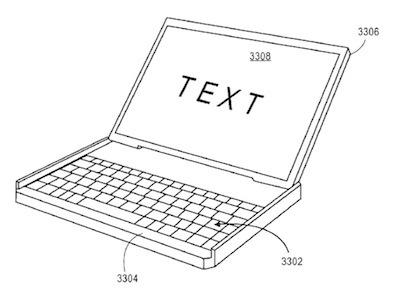
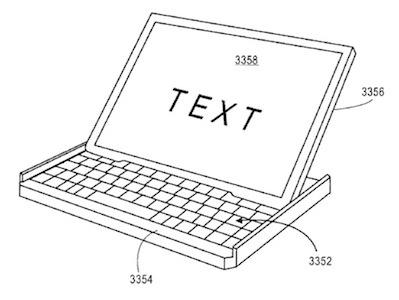
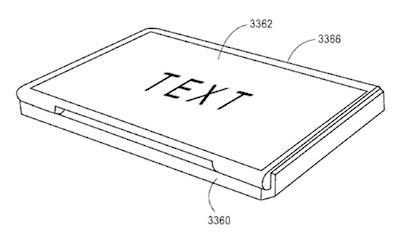
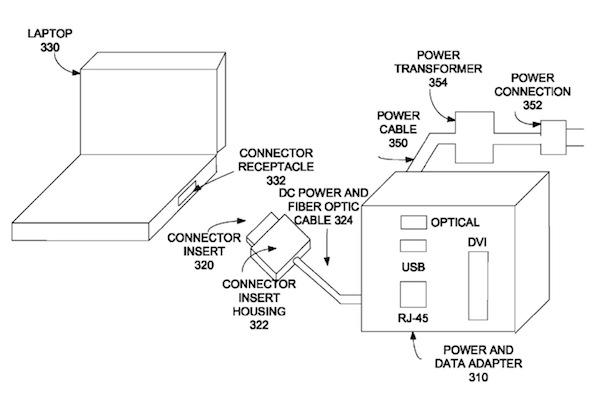
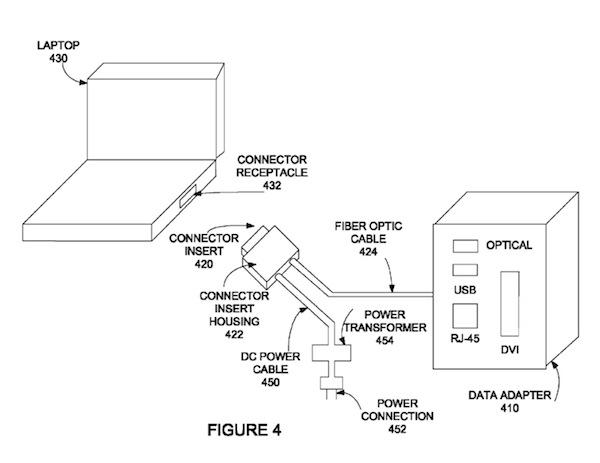







-m.jpg)






 Charles Martin
Charles Martin
 Christine McKee
Christine McKee
 Wesley Hilliard
Wesley Hilliard
 Malcolm Owen
Malcolm Owen
 Andrew Orr
Andrew Orr
 William Gallagher
William Gallagher
 Sponsored Content
Sponsored Content

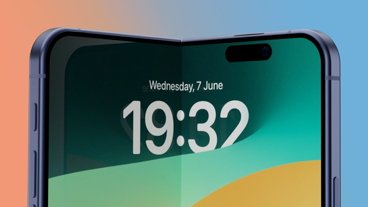






52 Comments
Full article
Patents granted to Apple on Tuesday reveal that the company is working on a device that converts from standard laptop form to tablet form as well as a magnetic connector that provides both power and an optical data connection.
Laptop to tablet
In a Nov. 30 patent titled "Application Programming Interfaces for Scrolling Operations," Apple depicts a laptop that slides into tablet form as an example of a device that would take advantage of the patent's scrolling operations.
The drawings first show a laptop with a traditional keyboard, body, display frame and display. Then, according to the patent, "the laptop device can be converted into a tablet device" by sliding the display across the keyboard.
Since the patent relates to scrolling operations, it would presumably not cover the convertible laptop to tablet form factor. Apple does, however, disclaim in the application that the patent contains "specific exemplary embodiments."
"It will be evident that various modifications may be made thereto without departing from the broader spirit and scope of the disclosure as set forth in the following claims. The specification and drawings are, accordingly, to be regarded in an illustrative sense rather than a restrictive sense," reads the patent.
In its recent revision. to the MacBook Air line, Apple took features from the iPad, such as "solid state storage, instant-on, amazing battery standby time, miniaturization and lightweight construction."
Apple CEO Steve Jobs said during the ultra-thin laptop's unveiling that he and his company had asked themselves, "What would happen if a MacBook and an iPad hooked up?" With both a touchscreen and a keyboard, laptop and tablet configurations, these figures from the scrolling operations patent reveal the possibility of an even closer integration between the two products.
One cable to rule them all
In another patent awarded Tuesday, Apple seeks to reduce the number of cables connected to a laptop device to a single connector that would provide both a power and data connection.
One drawing of the invention depicts what appears to be a MagSafe-like connector attached to a "power and data adapter" with optical, USB, Ethernet, and DVI ports. The adapter would function as both a power brick and a port hub.
Another drawing features a MagSafe connector that splits off into a fiber optic cable with a data adapter and a DC power cable with a power transformer.
The patent could be a first look at Apple's planned implementation of Intel's Light Peak optical cable technology. Intel is reportedly readying Light Peak for an early 2011 release, and Apple is expected to quickly incorporate the technology into its Mac line of computers.
Intel claims Light Peak has a bandwidth of 10Gbps and will scale up to 100Gbps over the next decade. "Optical technology also allows for smaller connectors and longer, thinner, and more flexible cables than currently possible," states Intel on its website.
Apple early on expressed heavy interest in Light Peak, "pushing" Intel to bring it to market. The cabling technology likely appeals to Apple because it would allow the company to roll networking, display, and peripheral cables into one master cable. Tuesday's patent reveals that the Cupertino, Calif., company is attempting to go one step further and bundle an optical cable with a power cable for an even more elegant solution.
[ View this article at AppleInsider.com ]
A convertible tablet from Apple could be very nice, I guess, although i don't quite get the equivocating language. Are they claiming that they seek to patent the whole idea of a convertible, so they shouldn't be held to whatever implementation they've depicted? Surely not.
As far as yet another adventure in crazy Apple I/O land, lord God help us all. If they want to put additional connectors on a power adapter, great. But I fear it would an excuse to remove all ports from the body of the machines, forcing us to rely on a crowed little dongle to connect to anything other than wirelessly.
Oh, and whaddyaknow-- "first."
A convertible tablet from Apple could be very nice, I guess, although i don't quite get the equivocating language. Are they claiming that they seek to patent the whole idea of a convertible, so they shouldn't be held to whatever implementation they've depicted? Surely not.
As far as yet another adventure in crazy Apple I/O land, lord God help us all. If they want to put additional connectors on a power adapter, great. But I fear it would an excuse to remove all ports from the body of the machines, forcing us to rely on a crowed little dongle to connect to anything other than wirelessly.
Oh, and whaddyaknow-- "first."
Seems to me that power "adapter" is basically an external dock. \
Seems to me that power "adapter" is basically an external dock. \
Which would be cool, but as I say, I fear that if Apple heads this way it will be in order to remove ports from the body of their machines.
OTOH, now that I think about it, a power adapter is the one accessory most people keep with their laptop at all times, so at least you'd be likely to have it around if you needed to hook something up.
An Apple laptop that also acts like an iPad is inevitable.